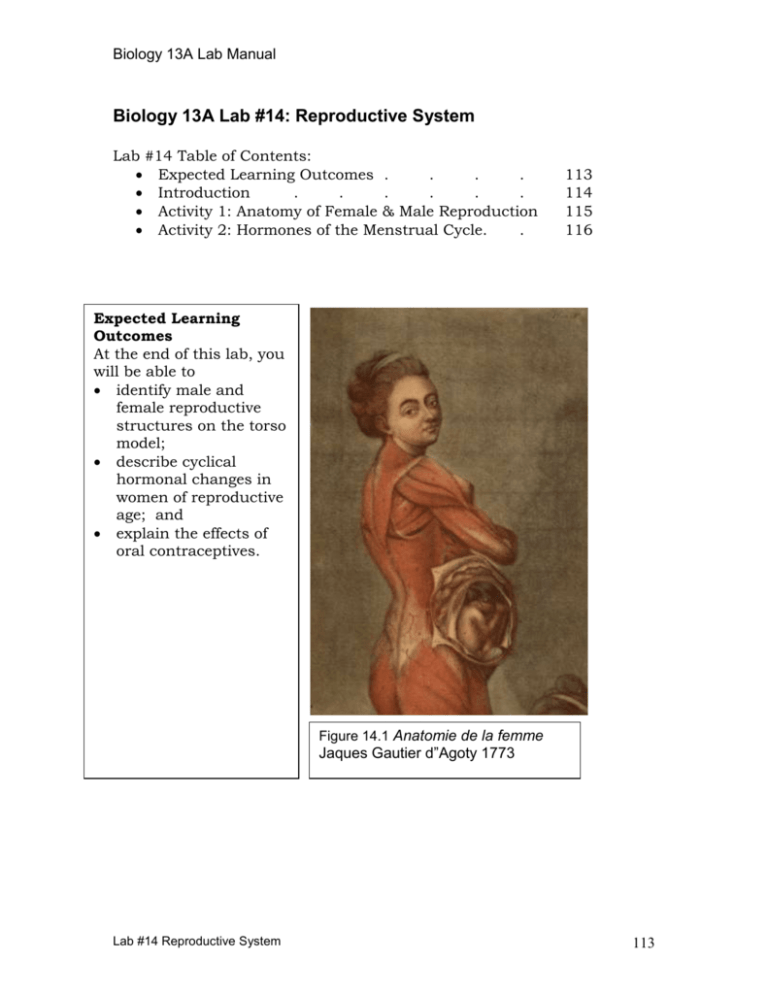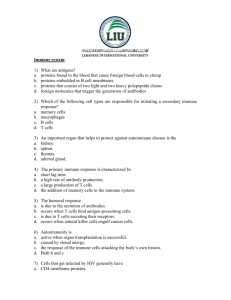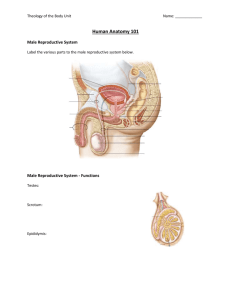Biology 13A Lab #14: Reproductive System
advertisement

Biology 13A Lab Manual Biology 13A Lab #14: Reproductive System Lab #14 Table of Contents: Expected Learning Outcomes . . . . Introduction . . . . . . Activity 1: Anatomy of Female & Male Reproduction Activity 2: Hormones of the Menstrual Cycle. . 113 114 115 116 Expected Learning Outcomes At the end of this lab, you will be able to identify male and female reproductive structures on the torso model; describe cyclical hormonal changes in women of reproductive age; and explain the effects of oral contraceptives. Figure 14.1 Anatomie de la femme Jaques Gautier d”Agoty 1773 Lab #14 Reproductive System 113 Biology 13A Lab Manual Introduction A fundamental feature of life is reproduction—the ability to pass on genetic information to a new generation. Humans reproduce sexually, that is, it takes both a male and female to produce an offspring. As mammals, females carry the embryo and fetus inside the uterus, where the growing individual is provided with nutrition, warmth, and transportation. After birth, female mammals produce milk to feed the infant. This pattern of reproduction is demanding (for the female), limiting the number of offspring she may produce over a lifetime. The trade-off is that the infant has a much greater chance of survival. Female anatomy and physiology accommodate the many tasks of female reproduction. First, females produce eggs with 1/2 the typical cellular amount of DNA. Once they reach the age at menarche (first menstruation), monthly changes in the ovary (ovarian cycles) occur. If an ovulated egg encounters sperm, conception, gestation (pregnancy), birth, and lactation may ensue. Male and female mammals, including humans, differ in reproductive anatomy and physiology because of the different roles they play in reproduction. Males, like females, produce gametes—in males these are sperm. Whereas females have virtually all the eggs they will ever have when they are born, males begin at puberty to Lab #14 Reproductive System produce millions of sperm each day, and they continue until they die. Women stop ovulating at menopause, which typically occurs decades before death. Female and male reproductive structures originate from the same tissues in the embryo. In males, genes on the Y chromosome stimulate the production of testosterone, and the male diverges from the common pattern. The gonads (ovaries and testes) develop in the abdomen but the male’s descend to the scrotum before birth, carrying the blood and nerve supply with them. The paired uterine (fallopian) tubes in females extend from the ovaries to the uterus. The uterus has a small opening to the vagina, which exits the body. Male reproductive anatomy consists of the testes, which produce sperm, and a series of tubes that lead through the penis to the outside of the body. The penis is an organ of copulation; it can become engorged with blood during an erection and can then introduce the sperm into the female reproductive tract (specifically, the vagina). Reproduction doesn’t end with copulation. Both men and women are engaged in raising children to maturity. In evolutionary terms, having offspring doesn’t mean a great deal unless they themselves survive to reproductive age. 114 Biology 13A Lab Manual Testing Your Comprehension: Answer the following questions based on your reading of the introduction. 1. What is the advantage for a species of pregnancy and lactation? 2. What are tasks of female and male reproduction? How does female and male reproductive anatomy and physiology reflect these tasks? 3. Define gamete, egg, sperm, conception, ovulation, menarche, and menopause. Activity 1: Anatomy of Female and Male Reproduction Use the human torso model to identify the following structures: Ovaries Uterine tube (fallopian tube) Fimbriae Uterus Endometrium Myometrium Vagina Figure 14.2 Female Anatomy Follow the path of an egg through the female reproductive tract, beginning at the ovary. Write down the structures through which it travels if a) it is fertilized, and b) if it is not fertilized. Testes in Scrotum Epididymis Ductus (vas) deferens Bladder Prostate gland Urethra Penis (shaft, glans) .3 Male Anatomy Lab #14 Reproductive System 115 Biology 13A Lab Manual Many aging men have enlarged prostrate glands. What would be the consequence? Activity 2: Hormones of the Menstrual Cycle A major difference between male and female reproduction is that, beginning at menarche and lasting until menopause, females have monthly cycles. Cycles are interrupted when a woman is pregnant or intensively lactating. The human menstrual cycle lasts about 28 days, and involves several different hormones. The purpose of the cycle is that, in mammals, the uterus must be prepared to accept and nourish the fertilized egg, and the sperm and egg must meet at the appropriate time so that the growing embryo is welcomed to a cushy environment. Growth and release of the egg and preparation of the uterus for pregnancy require a complex dance of hormones. These include follicle stimulating hormone (FSH), luteinizing hormone (LH), estrogen, progesterone, and human chorionic gonadotropin (hCG). These will be discussed in this section. Before birth, a female ovary contains immature egg cells called oocytes, which are in a dormant state until puberty. A layer of cells surrounds each oocyte and the entire structure is called a primordial follicle. Primordial follicles begin to mature when they are acted upon by follicle stimulating hormone (FSH) from the anterior pituitary. FSH is not secreted until the pituitary has been stimulated by gonadotropinreleasing hormone (GnRH) from the hypothalamus. Each month several follicles begin to develop but usually only one reaches maturity. During their development, follicles produce estrogen, which causes thickening of the uterine lining in preparation for pregnancy, should fertilization occur. Eventually, one follicle emerges as a mature, Graafian follicle and it will release an egg at ovulation. Ovulation occurs at mid-cycle, in response to a surge in leutinizing hormone (LH), another hormone of the anterior pituitary. LH levels increase in response to estrogen levels. Following ovulation, the remnant of the follicle, called the corpus luteum (CL), produces progesterone, another hormone that prepares and maintains the uterus to receive a fertilized egg. If the egg is not fertilized, the corpus luteum regresses, levels of progesterone and estrogen decline, the hypothalamus produces GnRH and FSH, and a new cycle begins. When estrogen and progesterone decline, the uterine lining is shed during menstruation. If fertilization occurs, the developing conceptus produces chorionic gonadotrpins (e.g., hCG), which maintains the corpus luteum. As pregnancy progresses, the placenta produces progesterone to maintain the uterus for successful pregnancy. Lab #14 Reproductive System 116 Biology 13A Lab Manual Graphing the Menstrual Cycle In this part of the lab you will create a graph of relative hormone levels; This will help you determine which hormone is most important during each part of the menstrual cycle. The menstrual cycle is a cyclic series of changes in the uterine lining that correspond with changes in the ovary. We will base our time line on a 28-day cycle, but the cycle is highly variable and in some women it is not a consistent length from one month to another. Since it is a cycle, we can begin with any phase. However, it is customary to call the first day of menstruation Day 1 of the menstrual cycle, because menstruation is visible and easy to document. During menstruation, the thickened lining of the uterus breaks down because there is no fertilized egg present. Dead cells of the uterine lining, blood, and mucus are released through the vagina. Menstruation lasts approximately 5 days. The second stage of the menstrual cycle is the follicular stage. During this time the egg completes the maturation process. This is the most variable part of the cycle in terms of length; it extends from the last day of menstruation to ovulation. The third phase of the cycle is the shortest. This is ovulation. It occurs around day 14 in a 28-day cycle. The final stage of the cycle is the luteal stage, when the corpus luteum is present. It lasts 13-15 days and is the least variable in length. This means that no matter how long the cycle, menstruation occurs about 14 days after ovulation. Procedure We will make a graph of hormone trends in the menstrual cycle. 1. Use the figure below for your work. Label the X axis “days” and label the Y axis “hormone level.” Break the Y axis into five parts. Assume a 28-day cycle. Along the X axis number from 1 to 28 (or label day 7, day 14, day 21, and day 28). Day 14 is in the middle, and is marked for you. 2. Title your graph “Hormone Variations During the Menstrual Cycle.” You will plot levels of estrogen, progesterone, FSH, and LH. You will be marking hormone trends on this graph, not be actually plotting data. (What is the difference?) 3. We will begin by graphing changes in estrogen level in the 28-day cycle. Use a green pencil to show estrogen levels on your graph. Start your line about one fifth of the way up your Y axis. Estrogen increases very gradually until it is almost four times the original amount around day 13. It then levels out at twice the original amount until just prior to menstruation when it decreases to the Lab #14 Reproductive System 117 Biology 13A Lab Manual original level. Increasing estrogen levels causes the pituitary to decrease production of FSH so that a second follicle does not complete maturation. In addition, estrogen is responsible for the thickening of the uterine lining. Increasing estrogen also causes a surge in LH. Graph Title: _________________________________ 4. Next, use a blue pencil to draw a line on your graph to indicate FSH levels during the cycle. FSH levels begin about half as high as estrogen. FSH levels increase to stimulate the development of the follicle. Beginning on day 1 of the cycle, FSH levels steadily increase until the middle of the cycle. It will peak about half-way up your Y axis and then steadily decrease to the starting level at the beginning of menstruation. Lab #14 Reproductive System 118 Biology 13A Lab Manual 5. Next, use a yellow pencil to draw a line on your graph indicating LH levels during the cycle. LH levels begin at about the same levels as FSH, but increase only slightly from the first day until around day 11. After day 11, LH levels increase rapidly and peak around day 13 at approximately four times the original level. Within two days, it returns to the original level and remains there throughout the remainder of the cycle. 6. Finally, use a red pencil plot a line on your graph indicating progesterone levels during the cycle. Begin about the same as FSH and LH and remain at that level until the middle of the cycle. At about mid-cycle progesterone levels slowly begin to increase over the next four days reaching about eight times the original level, then it slowly decreasing to the original levels at the end of the cycle. 7. In the space below the X axis of your graph, label the four phases of the menstrual cycle: Menstruation Follicular Stage Ovulation Luteal Stage Answer the Following Questions: 1. The changing hormone levels also cause the endometrium of the uterus to change in thickness. On which day of the menstrual cycle would it reach maximum thickness? Explain your answer based on how this would help to make sure pregnancy occurs if fertilization occurs. 2. a. What is the function of each of the following hormones: FSH, LH, estrogen, and progesterone? b. On what days of the menstrual cycle does each hormone reach its peak? c. Why aren’t all four hormones found at their highest levels at the same time? 3. What would happen if fertilization occurred but the CL was not maintained beyond day 28 of the cycle? 4. 4 a. Which two hormones discussed in this lab are produced by the pituitary gland? b. Which two are produced in the ovary? 5. Feedback occurs when the effect produced by a hormone causes the level of that hormone to change further. What are two Lab #14 Reproductive System 119 Biology 13A Lab Manual examples of feedback described in this lab? 6. Divide the diagram below to show the # of days involved in each phase of the menstrual cycle (like a pie graph). For each phase, indicate which hormone would be present in peak amounts. Menstrual Cycle Based on a 28 Day Cycle • Menstruation • Follicular Phase • Ovulation • Luteal Phase 7. Estrogen affects many parts of the body besides the uterine lining. It is also important in secondary sex characteristics. In addition, it increases the sense of smell and taste. a. Based on your graph, during which part of the menstrual cycle would these senses be most intense? How would this be an adaptation to increase the chances of conception? 8. Oral contraceptives often contain synthetic estrogens and progesterone for 21 days, and then placebo pills that do not have the hormones for days 22-28. Why would this prevent pregnancy? Do such pills prevent ovulation? Do they prevent menstruation? Explain. 9. A simple test that detects hCG is used for home pregnancy testing. Why are human chorionic gonadotropin (hCG) levels measured as an early indicator of pregnancy? Lab #14 Reproductive System 120 Biology 13A Lab Manual Portions of this lab were modified from an article by Frank, D. and Wright, N. 2000. The hormones of the menstrual cycle. Cornell Institute for Biology <Teachers.cibt.bio.cornell.edu/labs/>. Lab #14 Reproductive System 121







